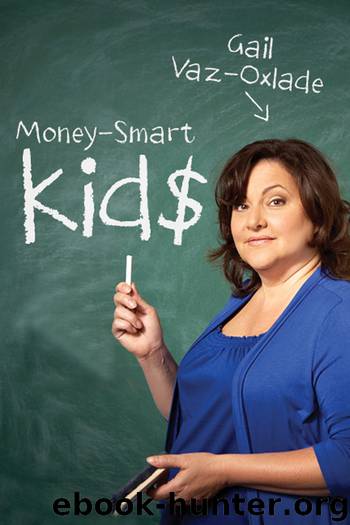Money-Smart Kids by Gail Vaz-Oxlade

Author:Gail Vaz-Oxlade [Vaz-Oxlade, Gail]
Language: eng
Format: epub
ISBN: 9781443410175
Publisher: HarperCollins Canada
Published: 2011-05-21T06:00:00+00:00
It’s important that you use a fairly high interest rate in your agreement. If you wuss out and charge just 5% a year, the lesson that using someone else’s money can be expensive is likely to get lost. Charge a whopping amount of interest (hey, department stores charge more than 24%), and the lesson will be made more real for your kids.
Your child can now use her credit card when she goes shopping with you. If she sees something she wants to buy, she gives you her card and you make the purchase on her behalf using your money. You give her a charge receipt. Remind her that if she doesn’t have the money at home ready to pay the card off in full when the bill comes in, she’ll have to allocate her future allowance (or babysitting money) to pay the bill when it arrives. Make the point clear: she is spending money she hasn’t yet earned, and she’ll pay interest to do so if she can’t come up with the money in time.
If she spends more than she can afford, or makes her payments late, you’ll have to charge her interest on the balance. Use 24% as your interest rate for this exercise, and don’t give in. To calculate the interest, multiply her monthly balance by 2% (which is the equivalent of 24% a year). So if she owes $16.50, the calculation would look like this: $16.50 x 2 ÷ 100 = $0.33.
Point out that she is paying that 33¢ for having used your money for a month. It is like she “rented” the $16.50 for a month, and the cost was 33¢. And if she doesn’t pay it off soon, it will continue to cost her money every month to keep “renting” the money she’s charged on her credit card.
Once your child is 16 or so (you’ll have to gauge his maturity), you may wish to get him an actual credit card (it will have to be in your name since only those 18 and older can have a credit card of their own) and start him using it and repaying it regularly. This is a habit, and one well worth the effort to form. By the time your child is 18, he should have a card in his own name so he can start building a credit history.
As you teach your credit lessons, don’t skip steps because you think they should be obvious to your teenager. Start by explaining how credit cards work.
Emphasize the connection between charging one month and paying the next: “Since there is a lag between when you use the card and when you must actually pay for the purchases you made, it is easy to forget what you bought. You need to keep track of what you’re buying and what you owe so that you know you’ll have the money to pay the balance when the bill comes in. Here’s a notebook to help you keep track.
Download
This site does not store any files on its server. We only index and link to content provided by other sites. Please contact the content providers to delete copyright contents if any and email us, we'll remove relevant links or contents immediately.
The Compound Effect by Darren Hardy(8513)
Tools of Titans by Timothy Ferriss(7815)
Nudge - Improving Decisions about Health, Wealth, and Happiness by Thaler Sunstein(7244)
Win Bigly by Scott Adams(6828)
Deep Work by Cal Newport(6563)
Rich Dad Poor Dad by Robert T. Kiyosaki(6179)
Pioneering Portfolio Management by David F. Swensen(6081)
Principles: Life and Work by Ray Dalio(5961)
The Barefoot Investor by Scott Pape(5590)
Digital Minimalism by Cal Newport;(5391)
Grit by Angela Duckworth(5300)
The Slight Edge by Jeff Olson(5200)
Discipline Equals Freedom by Jocko Willink(5157)
The Motivation Myth by Jeff Haden(5004)
You Are a Badass at Making Money by Jen Sincero(4657)
The Four Tendencies by Gretchen Rubin(4424)
Eat That Frog! by Brian Tracy(4149)
The Confidence Code by Katty Kay(4040)
Bullshit Jobs by David Graeber(3831)
